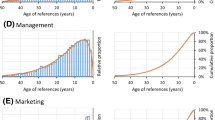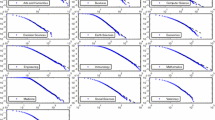Abstract
Different approaches are introduced for studying the growth of scientific knowledge, as reflected through publications and authors. Selected growth models are applied to the cumulated growth of publications and authors in theoretical population genetics from 1907 to 1980. The criteria are studied on which growth models are to be selected for their possible application in the growth of literature. It is concluded that the power model is observed to be the only model among the models studied which best explains the cumulative growth of publication and author counts in the theoretical population genetics.
Similar content being viewed by others
References
PRICE, D. J. DE S., Science since Babylon. New Haven, Conn., Yale University Press. 1961.
PRICE, D. J. DE S., Little Science, Big Science. New York, Columbia University Press, 1963.
CRANE, D., Invisible Colleges: Diffusion of Knowledge in Scientific Communities. Chicago, The University of Chicago Press, 1972.
KUHN, T., The Structure of Scientific Revolutions. Chicago, The University of Chicago Press, 1962.
STERMAN, J. D. The growth of knowledge: Testing a theory of scientific revolutions with a formal model. Technological Forecasting and Social Change, 28 (1985) 93.
MULKAY, M. J., Problem areas and research networks in science. Sociology, 9 (1975) 187–203.
TOULMIN, S., Foresight and Understanding. New York, Harper and Row, 1963.
TOULMIN, S., Conceptual revolutions in science. In: R. S. COHEN, M. W. WARTOFSKY (Eds), Boston Studies in the Philosophy of Science. Volume 3. Dordrecht, Holland, D. Reidel Publishing Company, (1967) 331–347.
HOLTON, G., Scientific research and scholarship: Notes towards the design of proper scales. Daedalus, 91 (1962) 362–399.
GOFFMAN, W., A. mathematical model for the growth of a scientific discipline. Journal of Association for Computing Machinery, 78 (1971) 173–185.
MULLINS, N.C., Theories and Theory Groups in Contemporary American Sociology. New York, Harper and Row, 1973.
COLE, F. J., EALES, N. B., The history of comparative anatomy. Part 1. A statistical analysis of the literature. Science Progress, 11 (1917) 578–596.
WILSON, P. W., FRED, E. B., The growth curve of a scientific literature: Nitrogen fixation by plants. Scientific Monthly, 41 (1935) 240–250.
GRANBERG, A., A Bibliometric Survey of Fibre-Optics Research in Sweden, West Germany, and Japan. Lund, Sweden, Research Policy Institute.
SULLIVAN, D. et al., The state of science indicators in the specialty of week interactions. Social Studies of Science, 7 (1977) 167–203.
TAGUE, J., BEHESHTI, J., REES-POTTER, L., The laws of exponential growth: Evidence, implications and forecasts. Library Trends Summer, (1981) 125–149.
BRAUN, T., LYON, W. S., BUJDOSÓ, E., Literature growth and decay: An activation analysis resume. Analytical Chemistry, 49 (1977) 682A-688A.
MAY, K. O., Quantitative growth of the mathematical literature. Science, 154 (1966) 1672–1673.
MENARD, H. W., Science: Growth and Change. Cambridge, Mass, Harvard University Press, 1971.
DAMASK, A. C., Mathematical models of scientific productivity. In: H. I. FUSFELD, R. N. LANGLOISES (Eds), Understanding R&D Productivity. New York, Pergamon Press, 1982, p. 97.
ANDERLA, G., Information in 1985: A Forecasting Study of Information Needs and Resources. Paris, OECD, 1973.
EFTHOMIADIS, E. N., The growth of the OPAC literature. Journal of the American Society for Information Science, 41 (1990) 342–347.
GUPTA, B. M., SHARMA, P., KUMAR, S., Growth of World and Indian literature. Scientometrics, 44 (1999) 5–16.
WOLFRAM, D., CHU, C. M., LIU, X., Growth of knowledge: Bibliometric analysis using online database data. In: L. EGGHE, R. ROUSSEAU (Eds), Informetrics, 89/90. Amsterdam, Elsevier, 1990, 355–372.
EGGHE, L., RAO, I. K. R., Classification of growth models based on growth rates and its applications. Scientometrics, 25 (1992) 5–46.
EGGHE, L., ROUSSEAU, R., Introduction to Informetrics. Amsterdam, Elsevier, 1990.
RAO, I. K. R., Growth, obsolescence, collaboration, and circulation statistics. In: I. K. R. RAO (Ed.), Workshop on Informetrics and Scientometrics, l6–l9 March 1998: Workshop Papers. Bangalore, Documentation Research and Training Center, Indian Statistical Institute, 1998, 4–5.
CROXTON, F. E., COWDEN, D. J., Applied General Statistics. London, Pitman & Sons, 1955.
FELSENSTEIN, J., Bibliography of Theoretical Population Genetics. Pennsylvania, Dowden, Hutchinson & Ross, Inc., 1981.
Author information
Authors and Affiliations
Rights and permissions
About this article
Cite this article
Gupta, B.M., Karisiddappa, C.R. Modelling the Growth of Literature in the Area of Theoretical Population Genetics. Scientometrics 49, 321–355 (2000). https://doi.org/10.1023/A:1010577321082
Issue Date:
DOI: https://doi.org/10.1023/A:1010577321082




